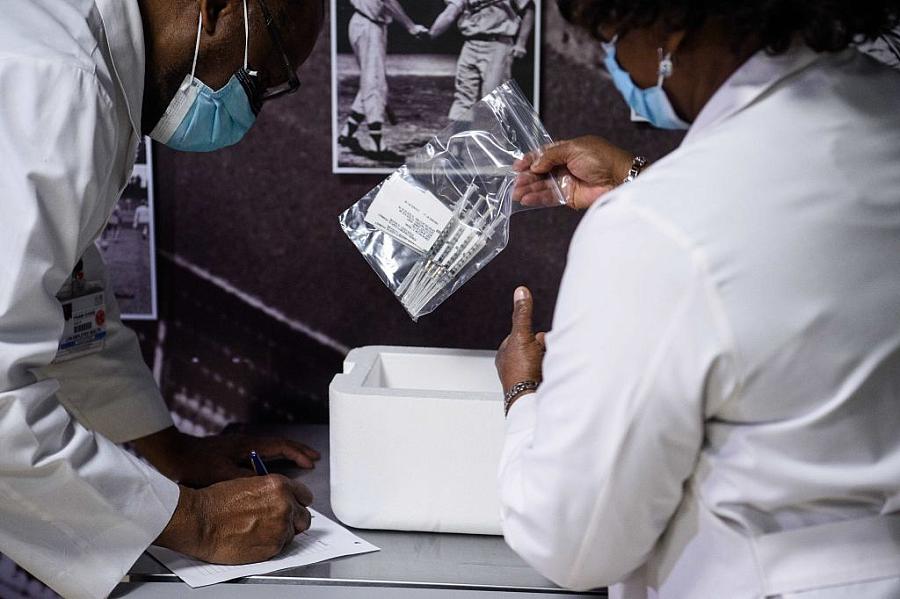A pro shares timely tips to give your vaccine coverage a boost

(Photo by Nicholas Kamm/AFP via Getty Images)
As Americans navigate the confusion and complexity surrounding the slow vaccine rollout, they’re turning to the media to clarify and explain what’s happening.
“This really is our moment in a lot of ways,” veteran journalist Lisa Krieger said. “I’ve never had the type of relationship with readers that I’m having right now.”
Krieger, the science and medicine reporter for The San Jose Mercury News, offered her pro tips for covering the vaccine rollout in a Center for Health Journalism Covering Coronavirus webinar on Jan. 14. She shared story and source ideas, and highlighted key questions journalists can use to guide their coverage.
“Things aren’t looking good and this is why vaccines are absolutely critical,” said Krieger, who in recent months has largely focused her reporting on vaccine coverage.
Morning routine and sources
Krieger has established a consistent “morning routine” that help her stay aware of the latest developments in this constantly evolving story.
She checks emails from the federal government as well as university communications including medical centers’ Grand Rounds (forums to discuss patient cases and developments). Krieger also reads The New York Times coronavirus newsletter, STAT and Science.
Twitter, a platform she once disliked for its “firehose” of information, is now the go-to place for vaccine news and updates. “Right now, it’s really where I find out what the leaders are thinking,” Krieger said.
Among the Twitter users she follows: @ashishkjha, @mlipsitch, @Bob_Wachter, @DrTomFrieden, @ScottGottliebMD, @T_Inglesby, @trvrb, @cmyeaton, @ASlavitt,@ArthurCaplan, @michaelmina_lab, and @DrNancyM_CDC
Useful podcasts include “In the Bubble” and “This Week in Virology.”
Five ways to cover the story
Krieger described five ways to approach the vaccination story. A Q&A pulls out the day’s facts in a reader-friendly way that often drives a lot of traffic. A consumer guide, or how-to story, offers the most up-to-date information on topics such as when and how people can receive vaccines.
Readers are also eager for analysis pieces, in which journalists take a step back and look at how the news has evolved or offer comparisons. People “want some explanation for how we got here,” Krieger said. Journalists have access to decision makers and can help answer these important questions.
Investigative pieces take a deeper look at what’s going wrong and why. Finally, Krieger’s personal favorite: Science articles, which explore cutting edge research and what’s next in the vaccine pipeline.
Tackle the big questions
Krieger pointed to several crucial questions that can guide journalists’ vaccine coverage and spur additional story ideas.
- Why is vaccine distribution so complex – and so much slower than expected?
Readers want to understand the disconnect between the number of vaccines being shipped to states and the amount of people receiving them. A common theme: Responsibility has percolated down to local public health officials who are already overwhelmed and under-funded, Krieger said. These local health officials are now being asked to do vaccine rollout on top of everything else. Useful data sources for tracking such stories include the Centers for Disease Control’s COVID Data Tracker, which includes a helpful map to compare your state with the rest of the county. The New York Times is tracking the number of doses and percent of the population vaccinated so far in all states. Bloomberg’s vaccine tracker, another solid source, offers a world map, too. Consider using your local data to create a helpful graphic for readers that shows how a given county or region compares to other areas.
- Everything keeps changing. What’s going on? Where am I in line?
While most of the states closely followed CDC vaccine eligibility guidelines at first (prioritizing health care workers and long-term care residents), states have since diverged as the rollout continues. Some states such as Florida started broadening vaccinations to residents 65 or older to prevent unnecessary bottlenecks. The federal government has now expanded the recommended eligibility threshold to 65 and older as well and many states and counties are struggling to revamp their own rollouts in response.
Journalists can play an important role here: Call up your state and county health officials to find out what’s happening on the ground, Krieger said. AARP has also been a helpful source with frequent updates on its site.
Some questions to spur reporting ideas: In your state, where in line are teachers, essential workers and people with medical conditions? How does your area plan to verify a person’s profession or medical conditions to determine eligibility? Where will the inoculations occur? How does your region plan to find people who aren’t being vaccinated, or follow up with people who need reminders for second doses? What is your state doing to make sure everyone has access?
Keep in mind that expansion of vaccine eligibility doesn’t guarantee more doses or provide the resources to run the operations.
- How will this fix my life and the economy?
Dr. Anthony Fauci, the nation’s leading infectious disease doctor, now says the country needs to approach a vaccination level of 85% before “true herd immunity” is reached for COVID-19.
“We, as journalists, need to know how many people are opting out,” Krieger said. Journalists also play a role in helping readers understand what happens to the economy if herd immunity isn’t reached.
The challenge isn’t just vaccine hesitancy. Krieger suggested looking into essential workers who don’t have easy access to health care, such as agriculture workers or unlicensed child care providers. The people who have historically had the least access are at the greatest risk for COVID-19. They need vaccines, but how do you reach them?
“I think that’s a great story,” she said. “The pandemic isn’t going to be over until we reach those folks.”
**
Watch the full presentation here:

